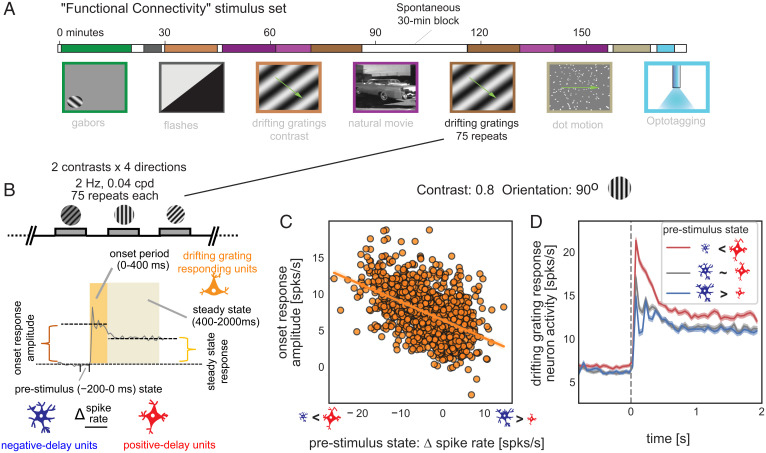Fig. 5.
Ongoing activity of the two neuronal ensembles predicts the amplitude of visual responses. (A) A diagram showing the “Functional Connectivity” stimulus set of the “Visual Coding – Neuropixels” project, which included a 30-min session with drifting gratings stimuli. (Image credit: Allen Institute.) (B) Illustration of the definition of the prestimulus state and the response amplitude to drifting gratings stimuli. The prestimulus state was defined as the spiking rate difference between the negative- and positive-delay neurons right before the stimulus onset (−200 to 0 ms), whereas the response amplitude was defined as the spiking rate change of the drifting-grating-responding neurons during the onset (0 to 400 ms) and steady-state (400 to 2,000 ms) stimulation periods as compared with the baseline period (−800 to 0 ms) without stimulation. (C) The prestimulus state of the negative- and positive-delay neurons is significantly correlated with the onset response amplitude of the drifting-grating-responding neurons to a drifting gratings stimulus (orientation: 90 degree; contrast: 0.8) across 1,050 trials pooled from all 14 mice (r = −0.50, P = 3.9 × 10−66). (D) Spiking rate of the drifting-grating-responding neurons were averaged within three groups of trials divided based on the prestimulus state: the bottom 350 trials (red) with the positive-delay neurons more active, the middle 350 trials (gray) with similar spiking rate between the negative- and positive-delay neurons, and the top 350 trials (blue) showing more active negative-delay neurons. Shadows represent regions within ±1 SEM across trials.

